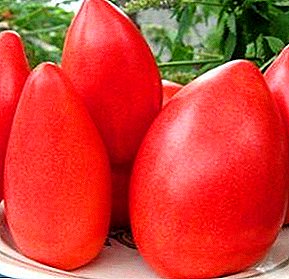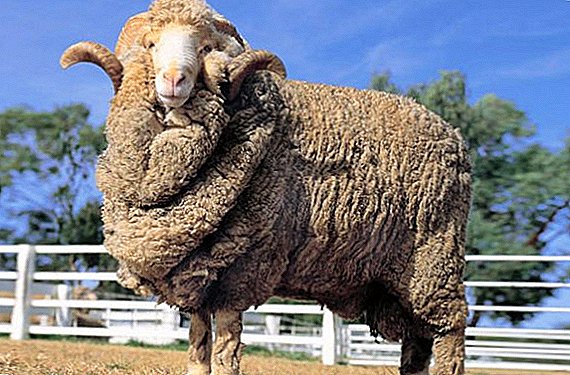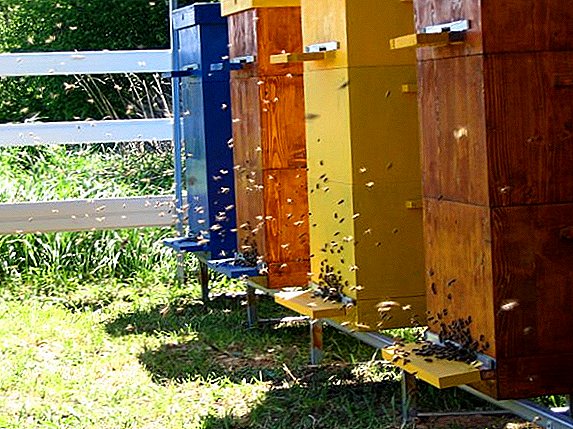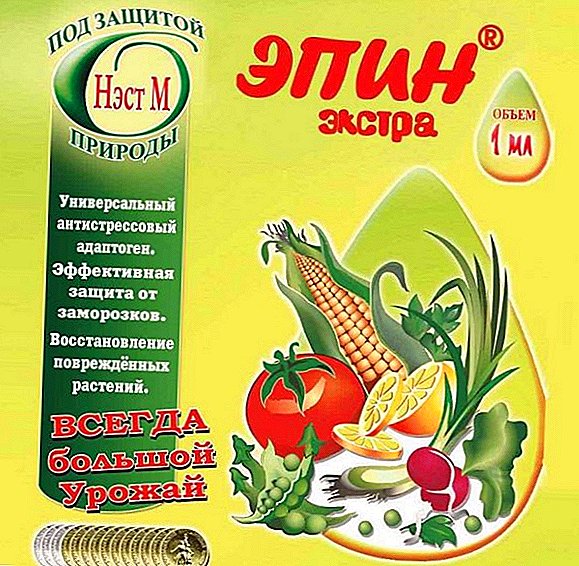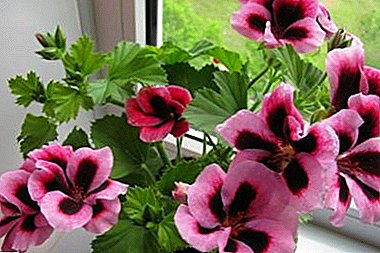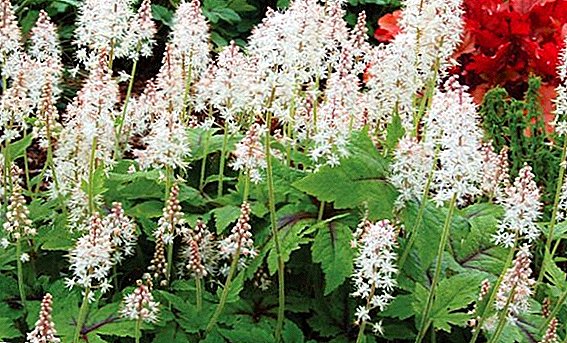 In the warm season, thousands of summer residents and lovers of living vegetation again and again come closer to their natural habitat. Most of them are trying to create a charming eye landscape right in their own summer cottage. In the case when you need to choose a light-loving type of ornamental plantings, many rely solely on their own taste and design solutions. But the majority of suburban areas are located in a mixed area of the light distribution. In this case, in a dense shade, it becomes rather difficult to choose a really interesting look, because few species grow in difficult low light conditions. The solution to this problem is breeding under a tree, next to a fence or in the shade of a house of plants belonging to the family of Kamenfoomkovy, among which tarka became the most popular. Below we consider what is Tiarell, the correct fit and care for her in the open field, with photos and detailed description.
In the warm season, thousands of summer residents and lovers of living vegetation again and again come closer to their natural habitat. Most of them are trying to create a charming eye landscape right in their own summer cottage. In the case when you need to choose a light-loving type of ornamental plantings, many rely solely on their own taste and design solutions. But the majority of suburban areas are located in a mixed area of the light distribution. In this case, in a dense shade, it becomes rather difficult to choose a really interesting look, because few species grow in difficult low light conditions. The solution to this problem is breeding under a tree, next to a fence or in the shade of a house of plants belonging to the family of Kamenfoomkovy, among which tarka became the most popular. Below we consider what is Tiarell, the correct fit and care for her in the open field, with photos and detailed description.
Botanical description
Tiarella or tiarka is a typical member of the stone-heel family. This is a grassy perennial plant that creeps near the soil and has a characteristic rosette with rounded, heart-shaped leaves.  A flower stalk is above the rosette, on average about 15 cm long. The inflorescence of the plant is quite memorable, the peduncle is covered with a brush with delicate cream-colored flowers.
A flower stalk is above the rosette, on average about 15 cm long. The inflorescence of the plant is quite memorable, the peduncle is covered with a brush with delicate cream-colored flowers.
As well as tiarell, the following types of plants are referred to as ground cover species: saxifrage, salt-water, English rose, creeping survivor, mimulyus.The plant belongs to the ground cover species. This means that throughout the growing season, tiake shoots grow horizontally and take root at each node.
Did you know? Flower name "tiarella" comes from the ancient Greek word "tiara", which is associated with the ancient headdress. This is due to the fact that the individual flowers of tiake resembled this ornament for the head.The typical length of the internode is about 10 cm, and the length of the shoots per year increases by an average of 30 cm. The flowering period for tiarella begins in the second half of spring. With the first warm days of May, the plant is covered with a plentiful inflorescence resembling lace.
 Flowering tiara continues until early June and lasts an average of about 30-40 days. At the end of flowering on the plant the fruit grows in the form of a box, about 9 mm in size, in which there are from 2 to 6 seeds of egg-shaped form.
Flowering tiara continues until early June and lasts an average of about 30-40 days. At the end of flowering on the plant the fruit grows in the form of a box, about 9 mm in size, in which there are from 2 to 6 seeds of egg-shaped form.This representative of Kamenelomkovy is a cold-resistant species, and also has no direct pests and pathogens in our latitudes. The native land of the flower is considered to be areas of North America. Also, wild representatives of the genus Tiarella are found in China, Korea and Japan.
Garden views
All representatives of tiarell differ in a very interesting variety of species and forms of representatives that are cultivated in areas of thousands of gardeners.
Among them you can find a flower with a heart-shaped leaf and finger-like, resembling a leaf of a maple. Among domestic gardeners the most popular types are:
- Tiarella polyphylla - a native of the subtropics Himalaya, so the species is characterized by poor winter hardiness, especially in the harsh northern regions.

- Tiarella cordifolia -one of the most winter-hardy species. The natural habitat is the territory of the mountain areas of Appalachia.
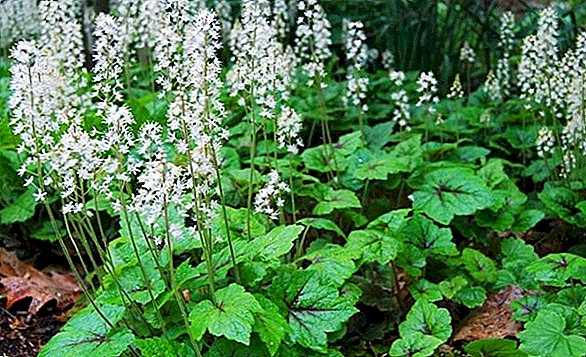
- Tiarella trifoliata- variety with bright pink flowers. A distinctive feature of the plant are three-fingered leaves.
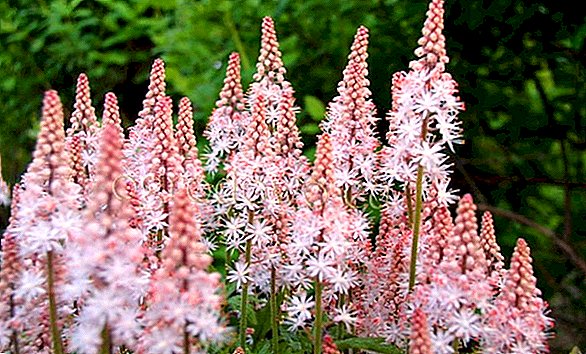
- Tiarella unofoliata- large bushy species that tolerates severe winters, as the natural habitat of its habitats are the western regions of Canada and Alaska.

Did you know? The three-leafed tiarella (Tiarella trifoliata) received its specific epithet exclusively thanks to Carl Linnaeus. It was this scientist who first noticed the ubiquitous division of the leaves of a plant into three leaflets, which is uncharacteristic of this species.Despite the fact that in domestic gardening the flower has not gained special popularity, in the West for more than a decade, new and more and more interesting tiarell varieties have been produced. Among them, special attention should be paid to:
- Tiarella "Black Snowflake"- one of the most beautiful representatives of tiarell. The leaves of the variety are distinguished by abundant fragmentation, the surface of which has a bright magenta shade with a glossy surface, and the flowers have a characteristic delicate pink shade.

- Tiarella "Iron Butterfly" - the variety is known for its unique leaf color. They have a green tint, strongly dissected, and in the center are fields of dark purple hue. Flowers with a light pink, almost white shade.

- Tiarella "Neon Lights" - This variety is often called a male plant. The leaves of the representative are strongly dissected, and in the middle there is a drawing of purple color, which gives tiarelle a slightly aggressive look. In this case, the flowers do not stand out strongly and have an almost snow-white shade.
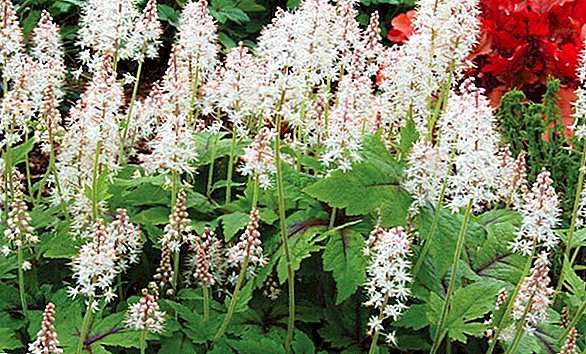
- Tiarella "Spanish Cross" -known for the interesting form of dissection sheet, which resembles church ornament. In the middle of the sheet is a purple smear, characteristic of the variety. Flowers delicate white and pink hue.

- Tiarella "Spring Symphony" - variety has gained popularity among overseas gardeners due to abundant flowering throughout the summer. For this, the plant needs special feeding and additional watering.

Location and soil for growing
All representatives kamnelomkovy unpretentious in the care. But, nevertheless, there are some subtleties that will help not only settle down on a flower in a flowerbed, but also look decent.
Such secrets are primarily based on the physiological features of the vital activity of the plant organism, in the correct approach to which accounting is the successful cultivation of tiara.  Below we take a closer look at what is the cultivation of tiarella, and also give examples of its planting and caring for it in the open field in the photo.
Below we take a closer look at what is the cultivation of tiarella, and also give examples of its planting and caring for it in the open field in the photo.
Choosing a place
In order to choose the right place for breeding tiarki, it is important to know one rule: these plants are shade-loving.
The sun will not destroy the planted flower, however, by planting it in a bright place, you can completely forget about the expected decorative appearance, as direct sunlight will not allow the flower to develop properly.  Better choose a place in the shade of tree plantings or building structures. The ideal option would be a dark place, in which long shadow periods and short light periods will alternate. The classic place for planting all the tiara is the edge of the garden paths.
Better choose a place in the shade of tree plantings or building structures. The ideal option would be a dark place, in which long shadow periods and short light periods will alternate. The classic place for planting all the tiara is the edge of the garden paths.
Important! Most professional gardeners do not recommend planting tiarella in flower beds. Due to the presence of antennae, it instantly grows and goes beyond the place reserved for it, which can completely disrupt the planned composition of the flowerbed.
Soil type
Kamnelomkovyh representatives recommended to plant on loose, drained soil. The alkaline balance of the environment is also important. Preferred for the family will be slightly alkaline soil, well, a weak root system needs only moisture-absorbing soils.
Landing tiarelly
Tiarca - This is one of the few types of proper planting and care in the open field for which you can learn from the photo. There is nothing difficult to plant this plant.  The technique of this process is the same as for other plants. In addition, the process facilitates the fact that all tiarelly tolerate transplantation perfectly throughout the growing season.
The technique of this process is the same as for other plants. In addition, the process facilitates the fact that all tiarelly tolerate transplantation perfectly throughout the growing season.
For proper planting of a flower in the soil, a small hole with a size of 20x20 cm is made. 20 g of complex fertilizer is poured into the prepared hole. It would also be great to combine fertilizers with 0.5 cups of wood ash and 1 liter of compost.  After that for 2 weeks it is necessary to water the bush plentifully to prevent its death. Thiarell reproduces vegetatively, and what is most interesting - throughout the year. To do this, part of the bush is just enough to make the room.
After that for 2 weeks it is necessary to water the bush plentifully to prevent its death. Thiarell reproduces vegetatively, and what is most interesting - throughout the year. To do this, part of the bush is just enough to make the room.
Beautiful perennial flowers for your flowerbed: anemone, aquilegia, astilbe, Badan, tuberous begonia, Brunner, Chistets, Edelweiss, Echinacea, Phlox, Gazania, geykhera.
Care features
Any representative of the stone-sawing unpretentious, but the flower tiarella and after planting requires appropriate care. Only this condition is a guarantee of the healthy existence of the bush in the dacha territory.
Watering
In the case when you decide to acquire this plant in a flower bed, remember, this is a moisture-loving representative of vegetation.  In the cold season, tarkas do not need watering, but this need is especially acute when the growing season begins. Therefore, in the summer hot season, the bush must be watered at least once a day.
In the cold season, tarkas do not need watering, but this need is especially acute when the growing season begins. Therefore, in the summer hot season, the bush must be watered at least once a day.
Fertilizer
Top dressing is carried out twice a year, in spring and after flowering, when buds of renewal begin to be laid. The average amount of mineral fertilizers to be applied with the calculation of 20 g per 1 sq. M.  Any compound fertilizer (AVA, Fertika, Bui fertilizers, etc.) is suitable for feeding.
Any compound fertilizer (AVA, Fertika, Bui fertilizers, etc.) is suitable for feeding.
We also recommend that you familiarize yourself with the natural dressings for your plants: banana peel, eggshell, nettle, onion peel, potassium humate, yeast, biohumus.
Pruning peduncles
Then, when the active flowering of tiarki is nearing completion, and flowers have stopped blooming on the peduncles, a period of rest begins. This time is the most suitable for circumcision.
This procedure cannot be called necessary, but the removal of dead parts of the flower will give a cultural look to the flowerbed and help it to bloom even brighter next year.  The procedure begins with a thorough inspection, it is necessary to clearly identify the dead parts of the stem, after which the shears or the knife must cut off the unnecessary wilted or dried parts. If by negligence you had to cut off a live fragment, put it in water, in such an uncomplicated way you will be able to propagate Chiara.
The procedure begins with a thorough inspection, it is necessary to clearly identify the dead parts of the stem, after which the shears or the knife must cut off the unnecessary wilted or dried parts. If by negligence you had to cut off a live fragment, put it in water, in such an uncomplicated way you will be able to propagate Chiara.
Important! After the flowering of the plant, it is important to wait a couple of weeks for a period of calm in order for the unnecessary parts of the stem of Tiarella to begin to wither, this will protect you from re-pruning of peduncles.
Wintering plants
For the most part, the cold period of the year is carried out without great difficulties. Before winter, the base of the Tiarella bush and the area around the root system must be mulched.
Young plants and less adapted to the cold species must be covered. When spring comes, mulch is not removed because the root can become bare.
Since the plant is an evergreen species when the first warm rays appear, the processes of moisture evaporation through the leaves are started.  Since the root is still unfrozen at this time, Tiarca feels a lack of moisture, which can lead to her death. Therefore, it is necessary to remove winter shelter gradually and with care.
Since the root is still unfrozen at this time, Tiarca feels a lack of moisture, which can lead to her death. Therefore, it is necessary to remove winter shelter gradually and with care.
Tiarella heart-shaped and other varieties in planting and care are unpretentious group of plants. Despite this, it is important to take into account all the peculiarities of the vital activity of the plant organism in order to turn the care of Tyaraka into a real holiday.
We hope that the materials reviewed by us will contribute to the development of decorative cattle breeding in our country.











